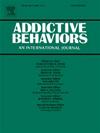Alcohol and cannabis as sleep aids among adolescents and associations with sleep quality and problematic use
IF 3.7
2区 医学
Q1 PSYCHOLOGY, CLINICAL
引用次数: 0
Abstract
Background
Using alcohol and cannabis as sleep aids is a growing concern among adolescents due to associated health risks. This study examined the prevalence of alcohol and cannabis self-medication practices among adolescents and explored the concurrent (Study I) and prospective (Study II) association with sleep quality and problematic use. Methods: One cross-sectional and one longitudinal (6-m onth interval) study were conducted. Participants comprised 1,121 Spanish adolescents aged 15 to 18 (57.1 % female) for Study I, and 221 for Study II (55.7 % female). Measures included sleep quality, pre-sleep cognitive and physical arousal, daytime sleepiness, and use of alcohol, cannabis, and self-medication. Multivariate analyses and Generalized Linear Mixed Models were applied. Results: In Study I, 8.6 % (n = 96) of adolescents reported past-m onth self-medication, which correlated with poor sleep, sleepiness, and higher pre-sleep physical arousal. Likewise, cannabis self-medication was associated with greater number of joints and problematic use. Study II showed a significant increase in self-medication rates after six months (from 6.3 % to 9.5 %). Regarding sleep, pre-sleep cognitive (OR = 1.3; 95 %CI = 1.0–1.8; p = 0.035) and physical arousal (OR = 1.1; 95 %CI = 1.0–1.1; p < 0.001) predicted alcohol self-medication. Poor sleep predicted cannabis self-medication (OR = 1.9; 95 %CI = 1.0–3.5; p = 0.047), which in turn increased the probability of poor sleep (OR = 2.2; 95 %CI = 1.0–4.8; p = 0.045) and problematic use (OR = 1.9; 95 %CI = 1.2–2.9; p = 0.003). Conclusions: Self-medication practices are common among adolescents, with increasing trends over time. Adolescents rely on substances as sleep aids, worsening their sleep and increasing problematic use. Findings underscore the need for preventive strategies to enhance sleep quality and reduce substance use.
酒精和大麻在青少年中的助眠作用及其与睡眠质量和不良使用的关系
背景由于相关的健康风险,使用酒精和大麻作为助眠药物在青少年中日益受到关注。本研究调查了青少年使用酒精和大麻自我治疗的普遍程度,并探讨了同时(研究 I)和前瞻性(研究 II)使用酒精和大麻与睡眠质量和问题性使用之间的关系。研究方法进行了一项横断面研究和一项纵向研究(间隔 6 个月)。研究 I 的参与者包括 1,121 名 15 至 18 岁的西班牙青少年(57.1% 为女性),研究 II 的参与者包括 221 名 15 至 18 岁的西班牙青少年(55.7% 为女性)。测量指标包括睡眠质量、睡前认知和身体唤醒、白天嗜睡、饮酒、吸食大麻和自我药疗。研究采用了多变量分析和广义线性混合模型。研究结果在研究 I 中,8.6%(n = 96)的青少年报告了过去一个月的自我药物治疗情况,这与睡眠质量差、嗜睡和睡前较高的身体唤醒度有关。同样,大麻自我药疗也与吸食大麻数量增多和吸食问题大麻有关。研究二显示,六个月后,自我药疗率大幅上升(从 6.3% 上升至 9.5%)。在睡眠方面,睡前认知(OR = 1.3; 95 %CI = 1.0-1.8; p = 0.035)和身体唤醒(OR = 1.1; 95 %CI = 1.0-1.1; p < 0.001)预示着自我药用酒精。睡眠不佳预示着大麻自我药疗(OR = 1.9; 95 %CI = 1.0-3.5; p = 0.047),这反过来又增加了睡眠不佳(OR = 2.2; 95 %CI = 1.0-4.8; p = 0.045)和有问题使用(OR = 1.9; 95 %CI = 1.2-2.9; p = 0.003)的概率。结论自我药疗在青少年中很常见,而且随着时间的推移呈上升趋势。青少年依赖药物作为睡眠辅助工具,导致睡眠质量下降,并增加了问题药物的使用。研究结果表明,有必要采取预防性策略来提高睡眠质量和减少药物使用。
本文章由计算机程序翻译,如有差异,请以英文原文为准。
求助全文
约1分钟内获得全文
求助全文
来源期刊

Addictive behaviors
医学-药物滥用
CiteScore
8.40
自引率
4.50%
发文量
283
审稿时长
46 days
期刊介绍:
Addictive Behaviors is an international peer-reviewed journal publishing high quality human research on addictive behaviors and disorders since 1975. The journal accepts submissions of full-length papers and short communications on substance-related addictions such as the abuse of alcohol, drugs and nicotine, and behavioral addictions involving gambling and technology. We primarily publish behavioral and psychosocial research but our articles span the fields of psychology, sociology, psychiatry, epidemiology, social policy, medicine, pharmacology and neuroscience. While theoretical orientations are diverse, the emphasis of the journal is primarily empirical. That is, sound experimental design combined with valid, reliable assessment and evaluation procedures are a requisite for acceptance. However, innovative and empirically oriented case studies that might encourage new lines of inquiry are accepted as well. Studies that clearly contribute to current knowledge of etiology, prevention, social policy or treatment are given priority. Scholarly commentaries on topical issues, systematic reviews, and mini reviews are encouraged. We especially welcome multimedia papers that incorporate video or audio components to better display methodology or findings.
Studies can also be submitted to Addictive Behaviors? companion title, the open access journal Addictive Behaviors Reports, which has a particular interest in ''non-traditional'', innovative and empirically-oriented research such as negative/null data papers, replication studies, case reports on novel treatments, and cross-cultural research.
 求助内容:
求助内容: 应助结果提醒方式:
应助结果提醒方式:


